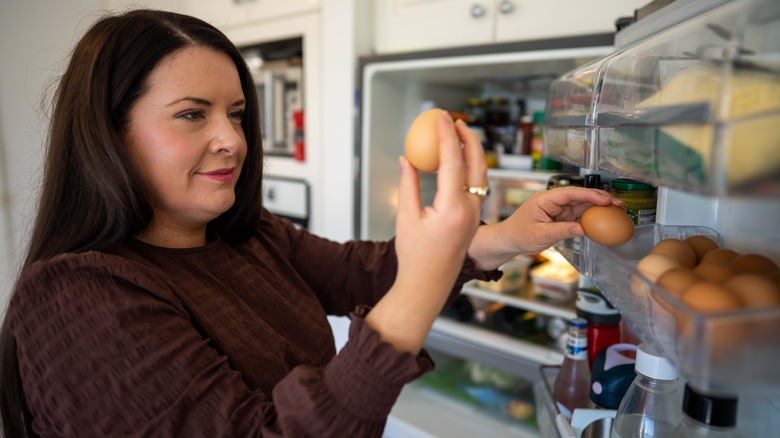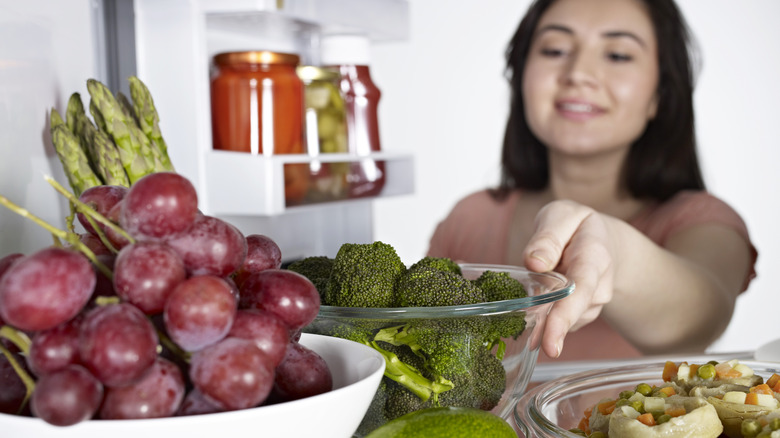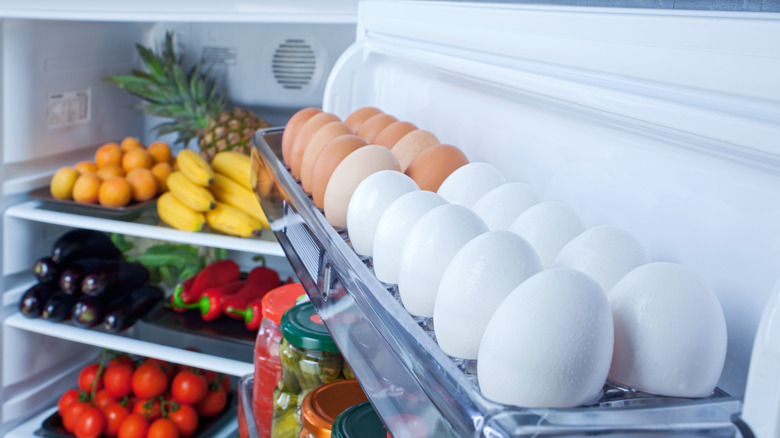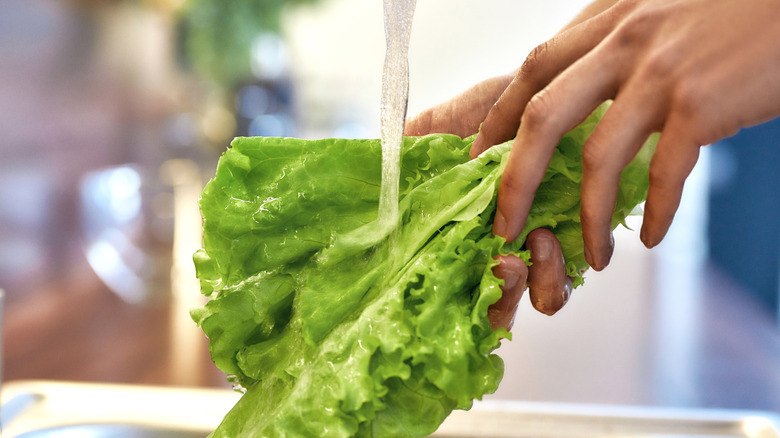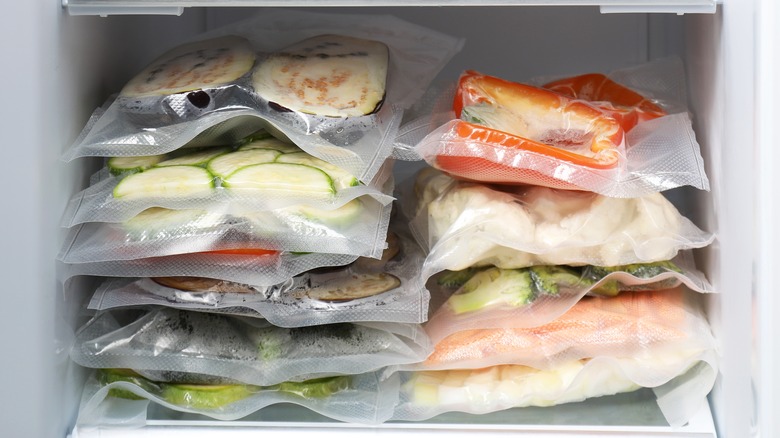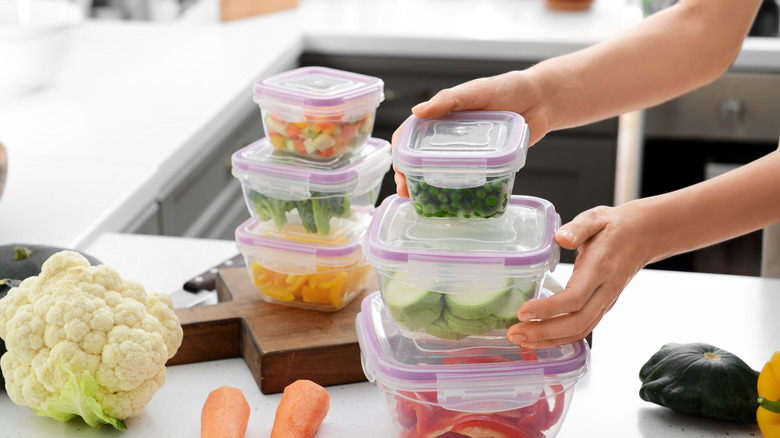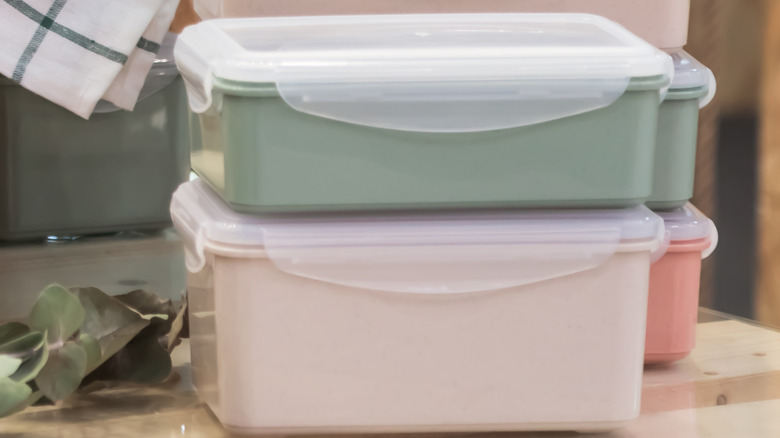These 9 Common Food Storage Mistakes Are Putting Your Health At Risk
Are food poisoning and foodborne illness the same thing? According to the USDA, while these terms are sometimes used as synonyms, food poisoning is technically a type of foodborne illness. What falls under the umbrella of foodborne illness includes allergic reactions because of food, as well as food making someone intoxicated or giving that person an infection because it contains microorganisms or toxins from microorganisms. However, if toxins in food are the culprit behind your getting sick, then you specifically have food poisoning.
Now, it's likely you've heard of some of the red flags to watch for when it comes to food. For example, you were probably told at an early age not to eat moldy bread. However, mold is just one possible culprit if a food makes you sick (via FoodSafety.gov). Others include bacteria, viruses, and parasites. And just as there can be different reasons why a food is unsafe to eat, the symptoms of eating such foods can vary and might include an upset stomach, diarrhea, nausea, vomiting, and fever. Additionally, there can also be long-term health problems from eating unsafe food, like brain and nerve damage. And, yes, it's possible to die from a foodborne illness.
Fortunately, properly storing food can help lower the risk of a food becoming dangerous to eat (per FoodSafety.gov). In addition to exploring food storage methods, we'll also discuss some specific foodborne illnesses. However, if you suspect you or someone else has a foodborne illness, seek medical help right away.
Refreezing melted ice cream
As Live Science notes, it's possible for Listeria bacteria to be in ice cream. Benjamin Chapman, a food safety expert at North Carolina State University in Raleigh, told Live Science that usually for Listeria to cause sickness, there would have to be " ... tens of thousands, or hundreds of thousands of cells ... " of it in a single serving of a food. But as Amreen Bashir, lecturer in Biomedical Science at Aston University, explains via The Conversation, the milk and sugar in melted ice cream can create favorable conditions for bacteria (including Listeria) and recommends not letting ice cream thaw and then refreezing it.
A Listeria infection can range from a mild intestinal illness to a potentially deadly invasive infection, via CDC. Although anyone can become ill from Listeria, the odds go up for newborns, as well as individuals who are 65 years old or older, are pregnant, or have weakened immune systems (per CDC). A Listeria invasive illness in someone who is pregnant can result in a premature delivery, a stillbirth, a miscarriage, or the newborn having a potentially deadly infection.
Listeria as an intestinal illness can involve vomiting and diarrhea (via CDC). Listeria as an invasive illness can cause flu-like symptoms and a fever in both pregnant and non-pregnant individuals, and someone who isn't pregnant might also experience balance issues, headaches, confusion, seizures, and neck stiffness. So, don't eat ice cream if you suspect it contains even a small amount of Listeria.
Stuffing too much food into your fridge
It's easy to overstuff a refrigerator, and not just with leftovers. For example, you might find a great deal if you buy in bulk. Or you might want to limit how many trips you make to the supermarket in a month, so you buy extra. However, the FDA warns that packing too much into a fridge can lead to foods not being properly refrigerated.
Registered dietitian Toby Amidor told Insider that the air flow in a refrigerator is important for proper food storage. Stuffing too much into a fridge can result in less air flow, which can lead to foods not being refrigerated at the right temperature. Once this occurs, there's a greater chance of bacteria multiplying. According to Food Safety News, Food Standards Scotland (FSS) stated that too much food in the fridge can result in food poisoning because of how it can affect the fridge's temperature and the potential growth of bacteria.
Besides not putting too much food in the fridge, another way to make sure that your food is being stored at the right temperature is by investing in two freestanding appliance thermometers (one for the fridge and one for the freezer). The FDA recommends keeping the refrigerator at 40 degrees Fahrenheit or below and the freezer at 0 degrees Fahrenheit. Also, you want to regularly clean out your refrigerator. After all, you might find that some of the food taking up space has spoiled.
Storing eggs in the wrong place in your fridge
As Vlatka Lake, a marketing manager at the storage company Space Station, notes to Reader's Digest, refrigerator doors typically have either built-in or insertable egg racks. But despite this, Lake states that this is a bad place to keep one's eggs.
According to the University of Minnesota, while manufacturers sanitize the outside of eggs, that doesn't mean the inside of an egg doesn't contain bacteria. As the Cleveland Clinic explains, the sometimes deadly food poisoning known as gastroenteritis (a.k.a. salmonella) is caused by Salmonella bacteria. You can have a chicken that appears healthy but has Salmonella bacteria, which is how that bacteria can be inside its eggs. Symptoms of salmonella include having a headache, as well as diarrhea that can contain blood, nausea, vomiting, and stomach cramps.
Although the body can thwart salmonella bacteria via stomach acid and the immune system, if a large enough amount of salmonella bacteria gets through the stomach and the immune system, a person can develop salmonella (via Cleveland Clinic). But cold enough temperatures can impede Salmonella bacteria from growing, per an article in Foodborne Pathogens and Disease. Jeff Nelken, a food safety expert and consultant, told Silver Sneakers that eggs should be kept on the lower shelves of a refrigerator since that's the coldest area of the fridge. He also said foods like juices, water, and condiments are alright to keep on the door. Nevertheless, if you think something has Salmonella bacteria, don't eat it.
Should you wash fruits and vegetables before refrigerating them?
To be clear, washing and cleaning your fruits and vegetables is important. But as WebMD points out, washing them, not drying them, and then putting them in the refrigerator while they're still wet can increase the chances of bacteria growing on them.
According to the University of Iowa Health Care, bacteria can flourish under certain conditions. For example, just as we get nutrients from fruits and vegetables, so too can bacteria. Also, these foods contain water, and moisture can help bacteria grow. So, if you add on top of that additional moisture from washing them, then that can set up a very favorable environment for bacterial growth. In fact, the University states that " ... fresh fruits and vegetables are at a high risk for bacterial contamination" and encourages storing produce properly to reduce the chances of this happening.
To cut down on the chances of bacteria growing on your fruits and vegetables, WebMD recommends waiting to wash them until right before you're going to consume or prepare them. Of course, there will be times that you'll need to wash them sooner (for instance, if you accidentally drop lettuce on the floor while putting away groceries). The key is to make sure whatever you're washing is dried thoroughly before it goes into the fridge. Also, WebMD notes that a salad spinner can dry foods like lettuce and spinach.
Vacuum sealing all your foods
According to the University of Iowa Health Care, oxygen can help bacteria grow, which makes low-oxygen environments ideal for food storage. As the University of Connecticut points out, vacuum sealing foods involves removing the oxygen from the food's package. But while this would seem like an ideal solution, not every type of food should be vacuum-sealed. In fact, doing so could increase the chances of that food making one sick.
Clostridium botulinum (the bacteria that causes botulism) can grow where there's no oxygen. With that said, the CDC states that botulism isn't common. However, it can certainly be deadly, since botulism causes muscle weakness, which includes the muscles that allow one to breathe. Other areas where muscles can be weakened by this illness include the arms, the legs, and the neck. And even parts of the body that aren't muscles can still be affected by botulism. For instance, one's eyes could be impacted because muscles control them.
Michigan State University notes that companies that make vacuum sealers advise against vacuum sealing certain foods because there can be a risk of the bacteria that causes botulism growing. These include fresh mushrooms and garlic, as well as raw onions. Additionally, vacuum sealing fish can be a concern. So, before vacuum-sealing your food at home, make sure to check with the device's manufacturer about what foods they recommend and advise against vacuum sealing.
Keeping food in plastic storage containers
Even though plastic storage containers are commonplace, registered dietitian Keri Glassman cautioned (per Insider) that keeping food in these containers could lead to chemicals in the plastic getting into your food. And one such chemical that has been garnering attention is bisphenol A (i.e., BPA), via Mayo Clinic.
According to the Mayo Clinic, food storage containers can contain polycarbonate plastics, which in turn contain BPA. Research supports that BPA can get into foods stored in such containers and that BPA might negatively impact the brain and the prostate, as well as such health issues as cardiovascular disease, type 2 diabetes, and increased blood pressure. Additionally, findings have also supported that BPA could adversely affect fetuses, infants, and children. With that said, the Mayo Clinic notes that based on the findings of hundreds of studies, the FDA's position is that BPA "is safe at the very low levels that occur in some foods."
In addition to BPA being in some food storage containers, the Mayo Clinic cautions that putting such containers in the dishwasher or the microwave can increase the likelihood of BPA getting into food. This is because, in both cases, the containers are subjected to high amounts of heat. So, you might want to store foods (especially if they're hot) in containers made from a material other than plastic. Glass, for example, can be a good choice for food storage.
Forgetting to write dates on your leftovers
From an early age, most of us are encouraged not to waste food. So, it's not surprising that a common item in many people's fridges is leftovers. But even properly stored leftovers can lead to food poisoning if you keep them for more than three or four days (via Mayo Clinic). This is because keeping leftovers for too long can set up favorable conditions for bacterial growth.
What's worse, a person who keeps leftovers for too long might think that if they still smell okay, they are safe to eat. However, as the Mayo Clinic warns, the scent, the appearance, and even the taste of food aren't altered by bacteria. And the likelihood of a leftover sitting for too long in your fridge can increase depending on the type of storage container you use. In addition to concerns about BPA regarding plastic storage containers, some plastic containers aren't see-through, per Insider. As registered dietitian Keri Glassman told Insider, this can increase the likelihood of not using leftovers within that three- or four-day window. As she explained to Insider, storing food in opaque containers means they're more hidden from view and more easily forgotten.
Of course, opting for see-through glass containers solves this problem regarding leftovers (per Insider). But it's still important to label those containers with both the date and the type of food, preferably using freezer tape.
Storing poultry, meats, and fish in the wrong place
We're warned about the dangers of letting raw poultry, meat, or fish touch other foods. However, as WebMD points out, putting any of these raw foods on the top shelf of a refrigerator can contaminate other foods in your fridge, even if they're on different shelves.
As WebMD explains, juices from raw poultry, meat, and fish can drip onto other foods, especially if they're on the top shelf. These juices can contain bacteria. For example, Campylobacter bacteria can be in meat, fish, and chicken, via CDC. So, let's say you do put raw chicken that has this bacterium on the top shelf of your fridge. If even just one drop of juice from that chicken lands on other food, that single drop has enough bacteria to cause a Campylobacter infection. Also known as campylobacteriosis, symptoms of this infection can include nausea, vomiting, and bloody diarrhea, as well as stomach cramps and fever. Temporary paralysis, irritable bowel syndrome, and arthritis might also occur because of a Campylobacter infection. Additionally, campylobacteriosis can be deadly for certain individuals, including someone with a compromised immune system.
WebMD recommends keeping raw fish, poultry, and meat on the bottom shelf and isolated from other foods. The USDA also recommends wrapping raw meat and poultry to help prevent their juices from leaking. Also, use dishes, pans, or bags when thawing them in the fridge.
Keeping bread on your countertop
From toast at breakfast to sandwiches for lunch, bread is a household staple. So, it's not surprising that one might want to keep bread handy by "storing" it on the countertop. However, Taste of Home advises against this, as bread is more likely to become moldy if it's in a place where there's sunlight. Heat and humidity can also increase the odds of mold growing on bread.
But just how bad is bread mold for your health? Consuming moldy bread can result in food poisoning and allergic reactions, per MedicineNet. The symptoms of food poisoning from moldy bread can include headaches, diarrhea, nausea, and vomiting. You can also have an allergic reaction to it by eating the bread or just inhaling the mold's spores. Allergic reactions to bread can affect one's breathing and cause sneezing, coughing, and even wheezing. It's also possible to have asthma attacks from bread mold and develop lung infections because of it. In addition, bread mold can be deadly for someone whose immune system is weakened.
To cut down on the likelihood of bread becoming moldy, keep it in a bread box or linen bag in a dry, cool area. Storing bread in the freezer is also an option, as long as the freezer is 0 degrees Fahrenheit. And while the refrigerator is cool and should help prevent mold, bread tends to become stale faster when refrigerated.

